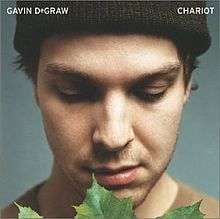Chariot (album)
Chariot is the debut studio album by singer-songwriter Gavin DeGraw, first released in 2003 on J Records. It was re-released in 2004 as Chariot (Stripped), which included all of the original Chariot content as well as a bonus disc. The bonus material was "stripped-down" (made simply and with minimal instrumentation) studio recordings of all of the original songs, as well as a cover of Sam Cooke's "Change is Gonna Come." The album was successful and was later certified Platinum in the United States.
| Chariot | ||||
|---|---|---|---|---|
 | ||||
| Studio album by | ||||
| Released | July 22, 2003 | |||
| Recorded | 2003 | |||
| Genre | Pop rock, soul | |||
| Length | 40:21 64:50 (Stripped) | |||
| Label | J Records | |||
| Producer | Mark Endert James Diener (Stripped) | |||
| Gavin DeGraw chronology | ||||
| ||||
| Singles from Gavin DeGraw | ||||
| ||||
| Review scores | |
|---|---|
| Source | Rating |
| Allmusic | |
| Allmusic | |
| Blender | |
| Common Sense Media | |
| Rolling Stone | |
| USA Today | |
Track listing
All songs written by Gavin DeGraw, except "Change Is Gonna Come" (for Stripped disc only) by Sam Cooke.
Original release
- Produced by Mark Endert
- "Follow Through" – 3:59
- "Chariot" – 3:59
- "Just Friends" – 3:25
- "(Nice to Meet You) Anyway" – 3:45
- "Chemical Party" – 3:01
- "Belief" – 4:27
- "Crush" – 3:25
- "Meaning" – 3:35
- "I Don't Want to Be" – 3:39
- "More Than Anyone" – 2:57
- "Over-Rated" – 4:11
Stripped disc
- Produced by James Diener
- "Follow Through" – 4:28
- "Chariot" – 4:59
- "Just Friends" – 4:49
- "(Nice to Meet You) Anyway" – 4:46
- "Chemical Party" – 4:54
- "Belief" – 3:09
- "Crush" – 3:20
- "I Don't Want to Be" – 4:04
- "Meaning" – 3:41
- "More Than Anyone" – 3:50
- "Over-Rated" – 6:22
- "Change Is Gonna Come" – 12:27
Personnel
- Alli – Art Direction, Design
- David Ashton – Assistant Engineer
- C.J. Buscaglia – Assistant Engineer
- Andrea Cooker – Stylist
- Kevin Dean – Assistant Engineer
- Gavin DeGraw – Piano, Keyboards, Vocals, Cover Art Concept
- James Diener – A&R
- Mark Endert – Producer, Engineer, Mixing
- Steve Gryphon – Programming, Editing
- Tosh Kasai – Assistant Engineer
- Tim LeBlanc – Assistant Engineer
- George Marino – Mastering
- Michael McCoy – Overdub Engineer
- Alvin Moody – Bass
- MiMi "Audio" Parker – Assistant Engineer
- Chris Reynolds – Assistant Engineer
- Maria Santana – Set Design
- Steven Sebring – Photography
- Michael Ward[7] – Guitar
- Joey Waronker[7] – Drums
- Patrick Warren – Organ, Harmonium, String Arrangements
Charts
| Chart (2003-2006)[8][9] | Peak position |
|---|---|
| Danish Albums Chart | 1 |
| Dutch Albums Chart | 6 |
| Italian Albums Chart | 43 |
| Finnish Albums Chart | 23 |
| Norwegian Albums Chart | 2 |
| Swedish Albums Chart | 21 |
| Swiss Albums Chart | 48 |
| US Billboard 200[10] | 56 |
| US Billboard Top Heatseekers[10] | 1 |
Certifications
| Region | Certification | Certified units/sales |
|---|---|---|
| Denmark (IFPI Denmark)[11] | Platinum | 30,000[12] |
| Norway (IFPI Norway)[13] | Gold | 20,000* |
| Netherlands (NVPI)[14] | Gold | 40,000^ |
| United States (RIAA)[15] | Platinum | 1,000,000^ |
|
*sales figures based on certification alone | ||
gollark: In any case, they have perfectly functional GPS receiver hardware which can also use cell towers.
gollark: SOme of them.
gollark: Phones also have barometers now.
gollark: Pretty sure it can.
gollark: > Do they have batteries/bluetooth/noise cancelling?Nope, generic cheap analog headphones.
References
- Allmusic review
- Allmusic review (Chariot + Chariot Stripped)
- Blender review
- Common Sense Media review
- Rolling Stone review
- USA Today review
- "J Records' Recording Artist GAVIN DEGRAW Readies Debut Album Chariot; Budding Star Performs at the RIVERSTAGES on May 2 at 7:30pm". www.businesswire.com. 2003-04-30. Retrieved 2019-12-02.
- Artist Chart History - Gavin DeGaw - Chariot
- Artist Chart History - Gavin DeGaw - Chariot - Stripped
- Artist Chart History - Gavin DeGaw
- "Danish album certifications – Gavin Degraw – Chariot". IFPI Denmark. Scroll through the page-list below until year 2006 to obtain certification.
- https://web.archive.org/web/20150117070449/http://www.ifpi.dk/?q=content%2Fguld-og-platin-i-august
- "IFPI Norsk platebransje Trofeer 1993–2011" (in Norwegian). IFPI Norway.
- "Dutch album certifications – Gavin Degraw – Chariot" (in Dutch). Nederlandse Vereniging van Producenten en Importeurs van beeld- en geluidsdragers. Enter Chariot in the "Artiest of titel" box.
- "American album certifications – Gavin Degraw – Chariot". Recording Industry Association of America. If necessary, click Advanced, then click Format, then select Album, then click SEARCH.
This article is issued from Wikipedia. The text is licensed under Creative Commons - Attribution - Sharealike. Additional terms may apply for the media files.